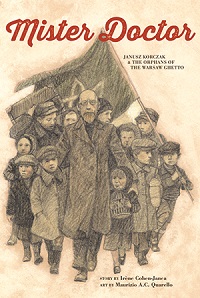| ________________
CM . . .
. Volume XXII Number . . . .September 25, 2015
excerpt:
There are some books that belong in every library collection. Mister Doctor is one of those gems children should read and have read to them several times during their formative years, a story that will make the lessons of the Holocaust resonate in their lives. Janusz Korczak (his adopted name) was a Polish-Jewish pediatrician, children’s writer and radio broadcaster. He was also the director of a Jewish children’s orphanage when World War II broke out. As the Nazi oppression increased outside the walls of the orphanage, Korczak did whatever he could to make his charges feel loved, safe and to give them hope. He knew the odds were against him; he was the little Henryk who was not allowed to bury his bird because “you’re Jewish, and your canary is Jewish, too.” State-sanctioned anti-Semitism and violent pogroms drove over two million Jews from their homes in Eastern Europe to North and South America before World War I. In the 1930s, the Nuremburg Laws, Kristelnacht, the ghettoes and the concentration camps sealed the fate of those who remained. French writer Irene Cohen-Kanca captures the terrible chapter of the Warsaw Ghetto and its liquidation in 1943 through the words of one child in the Jewish orphanage. She creates a voice that is innocent and believing, but one that senses the dark shadow looming:
The child recalls the culture of the orphanage – full of structure and responsibility, but also deep learning, kindness and the fostering of imagination. Korczak’s leadership made the children respond positively to his efforts to maintain a state of normalcy in their hungry, rat-infested, shrinking world - including making sure they kept up with their education, in spite of schools being prohibited in the ghetto. He presented an optimistic face to the children even after he was imprisoned and brutalized by the Nazis. Cohen’s sensitive, haunting text is set against sepia-toned pages and the pencil/charcoal drawings by Italian illustrator Maurizio A.C. Quarello. There is much darkness in the lives of these children; the only slight hint of colour is found in the memory of a story – an unreal world. The full details of the Warsaw Ghetto and the Nazi terror are absent from the text of Mister Doctor, but they infuse the narrative. The only consolation in this true story is that there were other adults like Janucz Korczak who refused an offer of freedom, unwilling to let the children go to their deaths in the gas chambers at Treblinka without loving arms around them. Korczak’s legacy is in his writings about the rights of children which influenced the United Nations 1989 Convention on the Rights of the Child. His twenty books – novels, literary writing, social journalism, articles, etc., are now being republished in Polish and in translation. Mister Doctor is a heart-wrenching book. Readers will personalize the feelings of displacement, hunger, confusion and fear a million innocent children all over Europe experienced at the hands of the Nazis. It should take its place as part of a teaching unit about the Holocaust, World War II, human rights, children’s rights, exceptional courage or death and loss. High school students, too, will find Cohen’s biography of this exemplary man a moving and valuable part of their education. In these days of war, ethnic cleansing and new forms of barbarity, Mister Doctor’s an instructive, relevant book. Highly Recommended.
Harriet Zaidman is a teacher-librarian in Winnipeg, MB.
To comment on this title or this review, send mail to cm@umanitoba.ca.
Copyright © the Manitoba Library Association. Reproduction for personal use is permitted only if this copyright notice is maintained. Any
other reproduction is prohibited without permission.
CM Home |
Next Review |
(Table of Contents for This Issue - September 25, 2015.)
| Back Issues | Search | CM Archive
| Profiles Archive |
